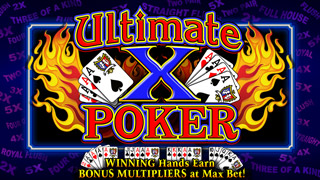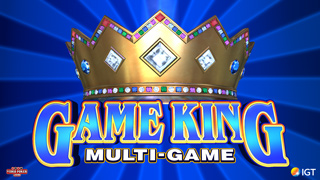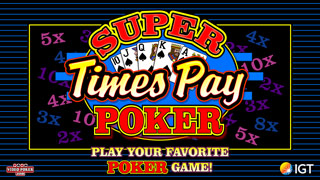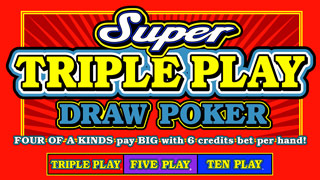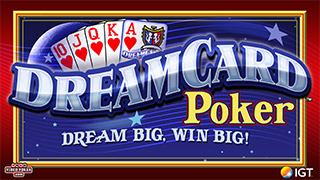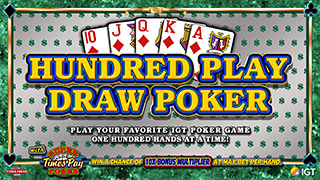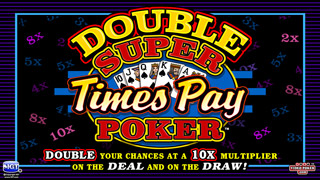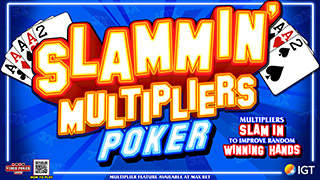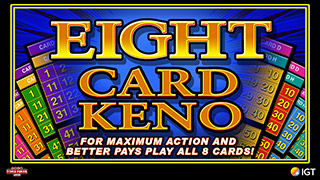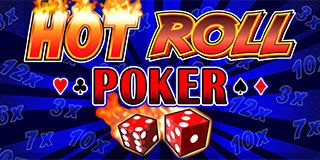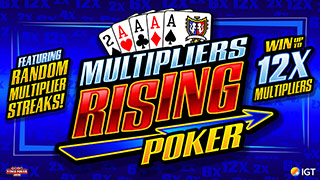Super Times Pay
-
cddenver
- Video Poker Master
- Posts: 2269
- Joined: Tue Mar 13, 2007 9:54 pm
Re: Super Times Pay
CD, I need some time to think about your graph, and will then comment again. Shadowman, your saying its just the roll of a 15 sided dice (or is it die)?
I'm sure that the curve I showed is a standard one in statistics and that it has a name, but I don't know what it is. That chart was for STP multipliers; I've put others together for RF's, Aces, SF's, 2's-4's, etc., all the way down to High Pairs The average intervals and min/max values for each hand type are different but the shape of the curve is always the same, with about 65% of occurrences coming up in less than the average interval. I've taken my own casino results for each "nice hit" type and plotted them as well, and those curves always match up with those I get from simulations. It was that as much as anything that convinced me the machines are on the up-and-up. Life imitates art, yet again.
-
New2vp
- Video Poker Master
- Posts: 1866
- Joined: Mon Sep 11, 2006 4:02 am
I'm sure that the curve I showed is a standard one in statistics and that it has a name, but I don't know what it is.This mode of displaying the results of a simulation provides a cumulative relative frequency distribution which is an estimate of the Cumulative Distribution Function or cdf for short. The cdf in this and many other cases can be derived theoretically if necessary, but the graph of the simulation shows one example of what you would see if the appearance of the multiplier is in fact random with probability 1/15. However, I don't think understanding is advanced too much here by simply knowing the name and cd's use of the information appears spot on.This graph is a description of sample data that answers the question what proportion of the time is the data in the sample less than or equal to a particular number, in this case, the number of hands between multipliers, read based on the height of the graph as measured on the vertical access, with the percentage or proportion read from the horizontal axis.One hopes that the sample is large enough and is repeatable so that it provides some sense of what is likely to occur in the future.
-
cddenver
- Video Poker Master
- Posts: 2269
- Joined: Tue Mar 13, 2007 9:54 pm
This mode of displaying the results of a simulation provides a cumulative relative frequency distribution which is an estimate of the Cumulative Distribution Function or cdf for short. The cdf in this and many other cases can be derived theoretically if necessary, but the graph of the simulation shows one example of what you would see if the appearance of the multiplier is in fact random with probability 1/15.
I knew all of that, of course, and was just feigning ignorance.
-
New2vp
- Video Poker Master
- Posts: 1866
- Joined: Mon Sep 11, 2006 4:02 am
I knew all of that, of course, and was just feigning ignorance. As usual, you had me fooled!
-
cddenver
- Video Poker Master
- Posts: 2269
- Joined: Tue Mar 13, 2007 9:54 pm
As usual, you had me fooled!
I'm so good at it that I've fooled a lot of people!
Thank you for putting a name to the face of that particular critter - "Cumulative Relative Distribution Frequency". I just updated the chart label in my copy of that chart so that if I post info like that again I'll be showing the proper term.
Now, I'll run a follow-up scenario by you. Let's stick with the STP multiplier example. Suppose that instead of a simulated sample of 1000 multipliers that the sample was my actual casino results. Suppose, too, that I'd posted the actual data instead of a chart and you'd confirmed that it was what you'd expect for an RNG operating randomly.
If we set the issue of illegality aside, I was thinking that it would still be possible for a casino to have cheated me on dollars by taking some multipliers away on favorable deals like 3oak's and 4 to RF's, and giving them back to me on junk hands. The overall rate of multipliers would be the same. Could that be detected? Cheating like that would be easier to detect if I also kept track of the hand types that multipliers came up on - over time you'd expect all dealt hand types to have the same rate - 1 in 15.
-
New2vp
- Video Poker Master
- Posts: 1866
- Joined: Mon Sep 11, 2006 4:02 am
If we set the issue of illegality aside, I was thinking that it would still be possible for a casino to have cheated me on dollars by taking some multipliers away on favorable deals like 3oak's and 4 to RF's, and giving them back to me on junk hands. The overall rate of multipliers would be the same. Could that be detected? Cheating like that would be easier to detect if I also kept track of the hand types that multipliers came up on - over time you'd expect all dealt hand types to have the same rate - 1 in 15.Sure it could be detected. One common test is called a Chi-square Test of Independence. You could do it with final hands or dealt hands. Since you suggested dealt hands, the test might look something like this:
Observed
Others
3oaks
4 to RF
Totals
Multipliers
2636
28
1
2665
No Multipliers
36000
800
18
36818
Total
38636
828
19
39483
Expected
Others
3oaks
4 to RF
Totals
Multipliers
2607.83
55.89
1.28
2665
No Multipliers
36028.17
772.11
17.72
36818
Total
38636
828
19
39483
Calculation
of Statistic [ (Observed - Expected)^2 / Expected ]
Others
3oaks
4 to RF
Totals
Multipliers
0.304
13.916
0.062
No Multipliers
0.022
1.007
0.005
Total
15.316
Degrees of
Freedom = (rows - 1) x (columns - 1) = 2
5.991465
0.000472
You set up your sample to keep track of the categories in columns vs. whether or not you get a multiplier (in the rows). Here, for example, we had 28 hands that were trips when we received multipliers. You could also track the value of the multipliers. You would do that by using more rows, one for each different multiplier. You could also have more columns if you wanted to track more hand types. A problem occurs in that if you are tracking rare occurrences like dealt 4-Royals or final hand Royal Flushes, you may need quite a big number of hands as your sample size as will be explained later.The "Expected Matrix" is made by calculating what would be in each cell if the hands were distributed independently of the multipliers. E.g., the upper left hand cell is calculated as follows: 38636 x 2665 / 39843 = 2607.83 (the product of the marginal totals divided by the grand total).Then you calculate the statistic as indicated in the calculation matrix with the same number of terms as you have cells. The upper left hand cell is (2636 - 2607.83)^2 / 2607.83 = 0.304Add up the 6 cells and you get 15.316. If the multipliers were distributed independent of the hand types, this statistic would be expected to follow what is called a chi-square distribution with 2 degrees of freedom. You get the degrees of freedom by multiplying (rows minus one) by (columns minus one).If there were independence, we would only get a statistic this big 0.0472% of the time, so with the sample indicated, I would suspect something was fishy with 99.9528% confidence. The biggest cell in the calculation (13.916) would be an indicator of what the problem is, in this case that we are receiving too few multipliers when we are being dealt trips. To calculate this number with Excel, you would enter "=CHIDIST(15.316,2)" or put the cell address in the formula in place of "15.316"; the second argument, 2, is the degrees of freedom.Usually if this value is less than 5%, many statisticians would reject the hypothesis that there was independence between the rows and the columns. Another way to look at this then would be to enter "=CHIINV(0.05,2)" into a spreadsheet to see what value your statistic had to beat for you to conclude that something not correct was occurring. This number is the 5.991465 figure at the bottom of my example above.Many older texts suggest that for this test to work well, we need numbers in the "Expected" matrix that are all 5 or greater. More recent work suggests that we won't have too much problem if a few of these numbers are as small as one. If you have that problem because we are dealing with situations that are too rare (such as 4 to the royals with a 10x multiplier), you can generally get around it by combining some rows together or combining some columns together.Detect away!
-
shadowman
- Video Poker Master
- Posts: 3587
- Joined: Mon Oct 23, 2006 5:42 pm
If you read some of the regulations you will see that the Chi-square Test is used to test any new machines before they are released.
-
New2vp
- Video Poker Master
- Posts: 1866
- Joined: Mon Sep 11, 2006 4:02 am
Thanks s-man, I wonder what the authorities do if the Chi Square Test fails. As with any statistical test, rarely, but sometimes, an experiment fails a test even when nothing is wrong simply due to an odd run of random numbers.
-
shadowman
- Video Poker Master
- Posts: 3587
- Joined: Mon Oct 23, 2006 5:42 pm
I would guess they just swap out the failing card and try a new one. I suppose they might send it back to the manufacturer who would probably do the same thing.
-
New2vp
- Video Poker Master
- Posts: 1866
- Joined: Mon Sep 11, 2006 4:02 am
I knew all of that, of course, and was just feigning ignorance. Something else that you probably knew. If you get tired of doing a simulation to approximate the cdf, you can calculate the cdf directly for any number n, where n is the number of hands between multipliers and p is the probability of hitting a multiplier on any hand. This cdf is:F(n) = 1 - (1-p)^nGenerally, this is graphed with the number of hands on the horizontal axis. Since you graphed it with the number of hands on the vertical axis and the cumulative probability on the horizontal axis, you actually graphed the inverse of the cumulative relative frequency distribution. If you start with the number of hands, you can find the cumulative probability (Q) by the formula above. However, if you want to start with the cumulative probability, you can find the number of hands from the formula:G(Q) = ln(1-Q) / ln(1-p) For example, here with p = 1/15, we can find the number of hands between multipliers 1/2 the time by substituting 0.5 for Q. Here we would get 10.05, so there will be 10 hands between multipliers slightly less than 1/2 the time.The average intervals and min/max values for each hand
type are different but the shape of the curve is always the same, with
about 65% of occurrences coming up in less than the average
interval.Great observation! The average theoretical interval here is 15 (or 1/p). For a p of around 0.09339, we do get extremely close to your observation of 65% of occurrences coming up in less than the average interval. As you noted, there is not much variation as p changes, especially as p gets closer and closer to zero as it does on rarer events such as quads and royals. For p = 1/15, the theoretical figure is 1 - (1- 1/15)^15 = 64.4736%. For a royal flush with say p = 1/40000, we have 1 - (1- 1/40000)^40000 = 63.2125%.There is an expression for the limit of this figure as p approaches zero:Lim (p --> 0) 1 - (1 - p)^(1/p) =1 - 1/e = 63.2121%where e = 2.718282 (approximately).If p < 1/65, you will always be correct within rounding to 1% if you say about 63% of the occurrences come up in less than the average interval.



